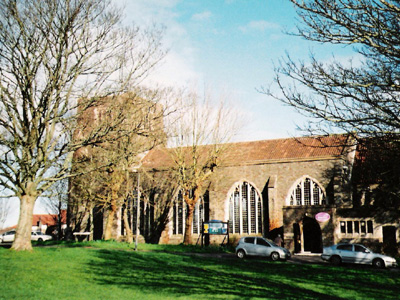 |
|

The church: St Oswald's, Bedminster Down, Bristol, England.
Denomination: Church of England.
The building: The church took one year to build in 1927. It became a church centre in 1983, with the aim of bringing people in from the local community by offering a variety of activities. In order to make the building more accessible and suitable (e.g. if you came in late to a service you had to walk past the altar in full view of everyone), it was reordered in 1998.
The church: The parish of St Oswald's serves residents living in 1930s housing to the south of the Victorian "old" Bedminster.
The neighbourhood: Bedminster is older than Bristol proper and may have got its name from the monastery or church founded by the monk Beda. Another source gives the origin of the name as the Old English word bedydd, which means baptism. The manor of Bedminster once encompassed all the land south of the river Avon. Bedminster flourished up to the thirteenth century and was on a par with other market towns such as Glastonbury and Frome further south in Somerset. In 1644, during the Civil War, Bedminster was sacked and burnt by Prince Rupert, an event from which it never fully recovered. By the middle of the 18th century, when John Wesley preached here, it was very much in decay. Its fortunes revived in the 19th century with the appearance of the open-cast mining and tobacco industries.
The cast: The Rev. John Lewis, vicar, was the celebrant. Mr Mike Bridges, lay reader, preached.
Book of Common Prayer Holy Communion.
How full was the building?
33 (but there was a family service to follow with another congregation).
Did anyone welcome you personally?
The churchwarden spotted that I was a stranger and asked me where I was from. She was very welcoming and reminisced about a mutual acquaintance from the church where I usually worship.
Was your pew comfortable?
Yes.
How would you describe the pre-service atmosphere?
Chatty.
What were the exact opening words of the service?
"Welcome to this, the best of winter days. If you are cold, you can sit on the heaters or jump around during the hymns." (This sort of informal style punctuated the whole service, e.g. the vicar suggested that we treat ourselves to a stiff scotch or sherry at lunch before reading the notice sheet.)
What books did the congregation use during the service?
Hymns Old and New and a parish booklet with the order of service.
What musical instruments were played?
Organ.
Did anything distract you?
Reciting the gloria during Lent.
Was the worship stiff-upper-lip, happy clappy, or what?
Relaxed low church.
Exactly how long was the sermon?
15 minutes.
On a scale of 1-10, how good was the preacher?
7 – Mr Bridges, an ex-naval man turned postman, had a broad Bristolian accent which reminded me how good it is to have lay readers genuinely enculturated as opposed to the traditionally posh and plummy voices of most Anglicans in England. The preacher teased out the gospel passage with lots of illustrations from a lighthouse, such as the feeling of depression.
In a nutshell, what was the sermon about?
Nicodemus wanted to have his cake and eat it; he was interested in Jesus but did not want to go public. To be born from anew, we have to put our lives into the hands of Jesus, with all the risks that involves. However, it is possible to do so one step at a time, taking bigger steps as we become more trusting. Giving up control is more important than giving up chocolates for Lent.
Which part of the service was like being in heaven?
I did not feel any emotional highs or lows, but I was reassured by the sermon. I like to control, so I can put off really trusting in God until the very last minute – or can I?
And which part was like being in... er... the other place?
I was irritated by the collect for the Queen (because I am a republican and it asks that we obey her). I was also irritated by the running commentary punctuating Cranmer's prayers. I do agree, though, that this made the service more user-friendly.
What happened when you hung around after the service looking lost?
The vicar and the reader explained a little about the building and its history.
How would you describe the after-service coffee?
Well, there was coffee.
How would you feel about making this church your regular (where 10 = ecstatic, 0 = terminal)?
6 – I am an Anglo-Catholic in churchmanship and this church has enough of the evangelical about it to make me squirm. But if I lived in this area I could get used to it, because the church does make an effort to relate to its local parish.
Did the service make you feel glad to be a Christian?
Yes, especially when I learned of the church's involvement in the local community.
What one thing will you remember about all this in seven days' time?
The vicar's suggesting that we get tipsy before reading the notice sheet.
| The Mystery Worshipper is sponsored by surefish.co.uk, the internet service provider from Christian Aid. By offering email services, special offers with companies such as amazon.co.uk and smile.co.uk, surefish raises more than £300,000 a year for Christian Aid's work around the world. Click here to find out how to become a Mystery Worshipper. And click here if you would like to reproduce this report in your church magazine or website. Top | Other Reports | Become a Mystery Worshipper! © Ship of Fools 2005 |